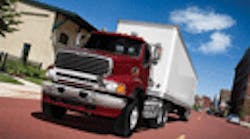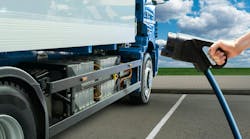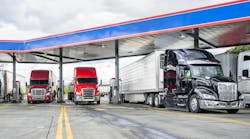LOS ANGELES -- Local civic and business leaders, executives from Daimler Trucks North America and members of the press gathered under tents here at the Ports of Long Beach and Los Angeles complex Monday to mark the delivery of 132 new natural gas (NG)-fueled tractors to drivers who contract with California Cartage Company, as well as 100 new NG trucks for the Ports’ Clean Truck Program. The event also marked the official debut of Daimler’s Set Back 113 NG truck.
The new trucks ringed a huge parking lot to mark the successful culmination of a project launched in November of 2006 that required the close cooperation and collaboration of the Environmental Protection Agency (EPA), the California Air Resources Board (CARB), the Southern California Air Quality Management District (SCAQMD) and California Cartage, a private company committed to building a clean drayage fleet. Nearly $12 million in grant funding for California Cartage’s project, provided by the SCAQMD using funding from a U.S. EPA grant and from California’s Proposition 1B program, helped to make the vision a reality.
“There are three things strike me as important to remember on this day,” said Mark Lampert, sr. vp of sales for Daimler Trucks North America and the master of ceremonies for the day’s activities: “First, we are located at the site of one of the most amazing operations in the world and in a state that is leading the change in commerce as well as the environment. Second, we are here to recognize acts of extraordinary leadership and celebrate how one idea, when supported by collaboration and hard work, can lead to profound progress. And last but not least, we are here to formally introduce innovation that, like landing on the moon, will forever meld world commerce with stewardship of the environment.”
City of Long Beach mayor Robert Foster noted that the trucks are a part of the effort to improve air quality in the area by 50% over five years. “A dramatic thing has happened here,” he said. “This is really a change. We are accounting for things we ignored in the past when we only looked at the first costs and the short term. For the health of our citizens and the health of the Port in the long run…this is the right thing to do.”
According to Chris Patterson, president & CEO of Daimler Trucks North America, each new truck delivered to the Ports will reduce the use of imported oil by 500 barrels per year, or more than 116,000 barrels annually for all 232 NG trucks, while helping to reduce pollution in the region. “This project should serve as a template for cleaning the atmosphere in urban areas while reducing dependence on imported energy sources,” he said.
The trucks Daimler is supplying are all set-back 113-in. BBC models. The initial batch are Sterling models and then will be followed by Freightliner units. Each truck is powered by LNG (liquid natural gas) features a Cummins ISLG 320 hp engine at 2000 rpm, driven through an Allison 3000 HS automatic transmission, which develops 1000 ft/lb of torque at 1300 rpm. It has a 12,000- lb front axle and 40,000- lb tandem rear axles with an estimated operating range of 250-300 miles between fuelings. The 113-inch BBC chassis boasts a comfortable, flat-roof conventional day cab. Features that drivers are apt to notice first: the smooth take-off and the quiet interior.
The NG trucks will replace some of the oldest and most polluting trucks at the Port facility. Qualifying owner-operators and small fleets will have access to the new trucks under a lease- to -buy program that brings monthly payments down to below $400 per month including maintenance, according to Bradley C. Fauvre, president of Velocity Vehicle Group. “The Clean Truck Program was developed to replace the oldest trucks at the Ports by subsidizing their replacement,” he noted. “When an old truck is traded in, they actually punch a hole in the engine block to make sure the old truck won’t end up back in service.”
The size of the NG truck project is in keeping with the scope of the pollution problem in the region, according to Dr. Chung Liu, deputy executive officer and chief scientist for the SCAQMD. “The area is still number one in terms of poor air quality,” he told the audience at Monday’s event. “There are 1,000 cases of cancer here for every one million residents and about 18,000 premature deaths per year linked to poor air quality. Really, the local communities deserve better.”
Bob Curry, Sr., president & CEO of California Cartage Company was honored as “the visionary” behind this ambitious project. “I don’t think that I am a visionary,” he said. “We just want to be a part of the solution, not a part of the problem.”
For Daimler Trucks, this project is only one part of a much larger global effort to achieve a “clean vehicle,” according to Chris Patterson, who noted that Daimler will invest $20 billion in research and development between now and 2010. “Because we know that there is no single answer to creating a clean vehicle, in 2008 we created a road map for sustainable mobility,” he noted. The program is based on three pillars: the ongoing optimization of vehicles with internal combustion engines; the further improvement of hybridization, and zero-emission driving with fuel cell and battery drive systems.




